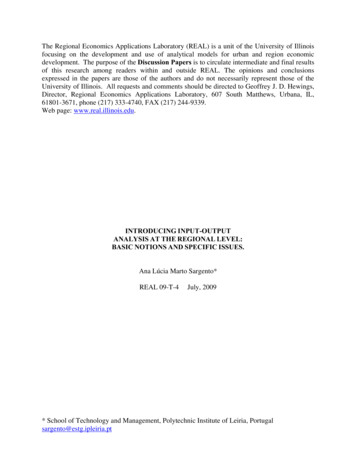
Transcription
INTRODUCING THE FUNDAMENTALSOF FINANCIAL PLANNINGA guide to getting started toward a personal financial plan.
RAYMOND JAMES: THE PIONEER OF FINANCIAL PLANNINGBack in 1962, when other firms were focused on buying and selling securities,our founder, Bob James, realized there should be more to a financialservices firm than just making investment transactions. He advocated amore thoughtful and deliberate approach to helping clients manage a widerange of matters that impact their lives. So, Bob made his vision a realityby creating a different kind of financial services firm – one that focused onclient goals rather than sales quotas.Today, Raymond James continues to steadfastly pursue Bob James’ vision.Everything we do is unflinchingly client-focused. Our unique culture ofindependence gives our advisors the complete freedom to offer objective,1962 Bob James foundsRobert A. James Investments.unbiased advice, so they can meticulously tailor a long-term plan basedsolely on a client’s well-being and specific goals.Following in Bob’s footsteps, your Raymond James advisor is able to give youthe close, personal attention you need to help you make the right decisionsfor your situation – and feel confident you have. That’s because he or she hasaccess to comprehensive support and a full range of resources from a global –and yet highly personal – financial services firm.At Raymond James, we view creating a financial plan as an opportunity toget to know you personally. We want to celebrate your accomplishments,your vision and your commitment to creating a tailored plan for your future.It’s a positive step toward financial independence, and we want to be withyou on that journey every step of the way.2
INTRODUCING THE FUNDAMENTALS OF FINANCIAL PLANNINGWHY YOU NEED A FINANCIAL PLANLife is full of competing priorities – some you plan for and some you don’t. You probably have anidea of the things you want to do that will require money. Things like buying a house, having children,paying for their educations and weddings, and having enough money for a comfortable retirement.But unexpected expenses like a broken-down car or hospital bill can strain anyone’s finances. Afinancial plan can put you in control so you stay on track regardless of what life throws at you –saving and investing in the types of financial vehicles that are specially designed for your objectives.Working with a financial advisor can help you build a foundation so that life doesn’t take you – or atleast your finances – by surprise. A financial advisor can advise you when there are changes in themarkets, tax legislation or the economy, and can help you adjust accordingly. An advisor you trust,and a financial plan you create together, will help guide you through the ups and downs to stay ontrack toward your goals.IT IS IMPORTANT TO MATCH YOUR GOALS WITH APPROPRIATEPLANNING STRATEGIES AND INVESTMENT VEHICLES.COMMON GOALSTIME FRAMEPLANNING STRATEGIES AND VEHICLESSaving for a weddingShort-termYou may consider a savings account or other low-risk accounts.Saving for a down paymentfor a homeShort-to-mid termMore conservative fixed interest rate accounts with appropriatematurities may be the best fit.Investing to fund collegeMid-to-long termDepending on your child’s age, slightly more risky investmentsmay be appropriate to provide greater growth potential. Taxadvantaged savings vehicles are also available when saving foreducation expenses.Investing for retirementLong-termYour portfolio has more time to weather the ups and downs ofthe markets, making riskier investments more suitable. Employerdefined contribution plans and other tax-deferred accountsprovide significant advantages when saving for retirement.Providing retirement incomeLong-termA structured income plan and balanced investment portfolio to helpmake sure you don’t spend money too fast or take too much risk overthe course of your retirement is essential. Disciplined withdrawalstrategies and guaranteed income sources can assist with this.Transferring wealth/estate planningLong-termAt this phase of life, planning for the orderly distribution of yourestate to heirs and minimizing tax burdens by taking advantage ofestate planning strategies will be a high priority.1
THE FINANCIAL PLANNING PROCESSHOW A DISCIPLINED ADVISORY PROCESS CAN HELP YOUDEVELOP A FINANCIAL PLANAt Raymond James, we emphasize the importance of counseling, identifying your needsand concerns, and building a customized financial plan designed to meet your specificobjectives. Developing your plan requires a solid understanding of your goals, investmentexperience, risk tolerance and much more.Your advisor can help break down the financial planning process into the following steps:2
INTRODUCING THE FUNDAMENTALS OF FINANCIAL PLANNINGUnderstand your needsYour financial advisor typically begins by getting to know you and your family while gatheringinformation about your current circumstances, your future goals, your concerns and your aspirations.During this phase, too, you and your advisor can discuss the strategies and services available to helpsolve the specific financial challenges you face.Design a comprehensive planDepending on your circumstances, your plan may focus on a single objective or a more complexstrategy. Your plan could be as singular as saving for retirement or a child’s education, monetizing aconcentrated equity position, or establishing a trust to benefit a child with special needs. But, perhaps,you may require a complex strategy that includes help with positioning and selling your business, thendeploying the proceeds, together with other investable assets, to deliver the income you need to retirecomfortably. Or you may be in need of multiple solutions: not only selling your business and developingan effective plan for retirement, but establishing a charitable trust to fund your philanthropic desires.Implement the planIn this phase, the planning is put into motion while collaborating with other relevant professionals asneeded – whether Raymond James specialists or your current attorney or CPA. The plan is based onyour goals uncovered in previous steps of the advisory process and factors in your investment horizon,as well as the types and levels of risk that you can afford and with which you’re comfortable.Manage the plan once it’s in placeFinancial planning is an ongoing process in which it’s essential to monitor the progress of yourinvestments within the context of your goals and periodically review all relevant information. It maybecome necessary to adjust the particular components of your plan in light of changing circumstancesand evolving objectives. Should economic and financial circumstances warrant, your advisor may alsorecommend tactical changes to your portfolio – while still adhering to your long-term goals.3
LIFETIME PLANNING STAGESLAYING THEFOUNDATIONLife is a long journey. Each new stage presents both financial challenges andopportunities. The key is to identify your needs, objectives and resourcesand understand what to expect during each phase of your life. The followingsteps can help guide you through this process as you develop, tweak andmonitor a financial plan throughout your lifetime.GROWINGYOUR ASSETSLAYING THE FOUNDATIONIn order to lay the foundation for your financial future, you’ll need to balanceyour priorities and create a plan. The earlier you start, the better your chanceof building a solid financial foundation that can grow with you and supportyour near-term needs and long-term goals. Over time, small but disciplinedcontributions to an investment account can help you meet your goals – plusMAKING THETRANSITIONestablish a lifetime habit of saving.And it’s never too late to start. You may have been saving and investing foryears without a formal strategy, but there’s no time like the present to pull itall together into a structured financial plan.SPENDINGYOUR MONEYWISELYSavingIt’s important to maintain an appropriate balance between spending andsaving. Create a budget in which you spend less than you earn. Identify yourmore immediate needs, such as housing and utilities, and prioritize yourwants, such as taking a vacation, buying a car or starting a family. Allocate aLOOKING TOTHE FUTUREportion of your budget toward both short- and long-term goals.Equally important is managing and eliminating debt. If you have debt, you shoulddevelop a plan to systematically pay it down and avoid accruing new debt.Emergency cashYou should always keep some portion of your money as cash or cashalternatives in liquid investments like savings, checking and money marketaccounts. Many financial experts recommend that you hold approximatelythree to six months’ worth of living expenses in cash and highly liquidinvestments.4
INTRODUCING THE FUNDAMENTALS OF FINANCIAL PLANNINGGROWING YOUR ASSETSOnce you have a financial plan in place, you can focus on accumulating assets to support yourself,your family, your career and your future. You’ll likely be forced to manage competing needs and goalsby prioritizing and planning accordingly, considering the relationship between your current lifestylechoices versus future needs.InvestingSelect investments best suited to your needs, constraints, obligations and goals. To mitigatevolatility within your portfolio, develop a diversified asset allocation strategy designed to meet yourfinancial goals yet reflect your tolerance for risk. Identify risks and purchase appropriate insurancewhere needed, such as renter/homeowner, health, life and disability policies.When planning for retirement, start early and take advantage of the power of compounding interest,particularly in tax-advantaged accounts such as an employer 401(k) plan. Factor in retirement,medical, life and disability benefits with your overall planning. When planning for college, evaluateall education funding options that both you and your child can take advantage of, from savings plansto scholarships.POWER OF COMPOUNDING OVER TIME: TAXABLE VS. TAX-DEFERRED ACCOUNTSBENEFITS OF DEFERRING TAXES* 250kValue of Taxable AccountValue of Tax-Deferred Account2001501005005 Years 10to Retirement15202530354045*Past performance is no guarantee of future results. An investment cannot be made directly in an index. Hypothetical value of 10,000 investedin stocks. This example is for an investor in the 28% bracket using the 2011 tax code. Assumes an 8% annual total return. Estimates are notguaranteed. This is for illustrative purposes only and not indicative of any investment. Created by Raymond James using Ibbotson PresentationMaterials. 2012 Morningstar. All Rights Reserved. 3/1/20125
MAKING THE TRANSITIONAs you move closer to retirement, your priorities will shiftretirement income plan. Other factors you shouldagain and new concerns may arise. Your planning shouldconsider as you transition toward retirement include:shift as well, from accumulation to distribution. Now’s the Caring for an elderly parenttime to begin developing a sensible plan for how you’llspend money in retirement and how to generate incomein the years ahead.Transition strategies may include maxing out retirementcontributions, considering rollover options and creatingstrategies for distribution. Prepare to transition intoretirement by estimating when you expect to retire, andmap out your “exit strategy” well in advance of that date.Learn more about government benefits such as SocialSecurity and Medicare to help ensure you receive the Assisting adult children Consolidating your investments and other financialaccounts wherever possible to build a simplifiedprocess for managing cash flow Planning for healthcare, Medicare, long-termcare and emergency expenses in your overallfinancial plan Drawing up a will and incapacity documents;discussing your wishes for estate distributionand charitable givingmost from them, and integrate them into your overallUNDERSTANDING HOW THE KEY ELEMENTS OF YOUR FINANCIALPICTURE WORK TOGETHER IS THE FIRST STEP IN CREATING APERSONALIZED RETIREMENT INCOME PLAN.6
INTRODUCING THE FUNDAMENTALS OF FINANCIAL PLANNINGSPENDING YOUR MONEY WISELYLOOKING TO THE FUTURETake the time to lay out a solid plan for how you willYou can live well and make an impact through yourspend your retirement. You will find that in order tolegacy with estate planning strategies designed to helpachieve goals and conserve resources, you will havepreserve assets. Collaborate with your professionalto manage both your spending and the preservation ofadvisors to develop a coordinated strategy thatassets you have accumulated. It is important to identifyoutlines to whom, where and how you want your assetsand plan for key unknowns, such as the potential needdistributed. Consider the causes you care about mostfor long-term care. Retirement is also the time to shiftand create a tax-advantaged charitable giving strategy.your portfolio strategy from one focused on generatingreturns to one designed to provide consistent incomeand preserve wealth while keeping pace with inflation.TransferringFinancial planning prepares you for all of life’s stages,including the decisions you make about passing alongDevelop and stick to a sustainable spending policyyour assets to heirs. A well-constructed estate planthat differentiates your needs from your wants and iscan help ensure that your affairs will be handled in thedesigned to make your money last throughout retirement.manner you prefer, by the person of your choice.ConservingEstate planning techniques have dramatically changedMany investors, particularly retirees, invest primarily toover the past decade to meet the requirements ofachieve a steady income that can keep up with, or exceed,more complex laws. No longer is it simply a matter ofcost-of-living increases. Equity investments designeddistributing your assets through a will. Direct transfersfor this objective may help people on fixed incomesto beneficiaries, revocable living trusts, insuranceobtain p
A guide to getting started toward a personal financial plan. INTRODUCING THE FUNDAMENTALS OF FINANCIAL PLANNING. 2 RAYMOND JAMES: THE PIONEER OF FINANCIAL PLANNING Back in 1962, when other firms were focused on buying and selling securities, our founder, Bob James, realized there should be more to a financial services firm than just making investment transactions. He











